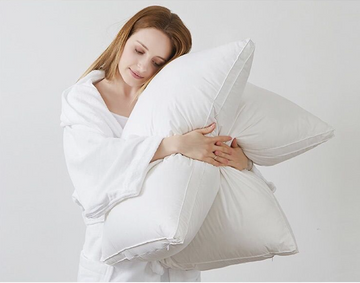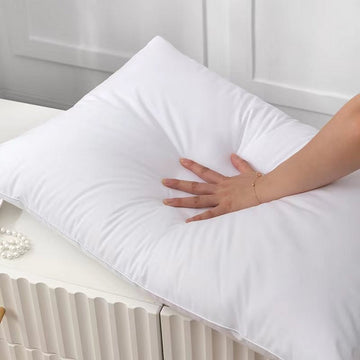Understanding the Coolest Comforter Types
The Science Behind Cooling Comforters
Understanding why some comforters keep you cool starts with science. The body needs to drop its core temperature for sleep. That's when cooling comforters come in. They are made with special materials that draw away heat. This means better sleep, even on warm nights. They also help manage moisture. This takes away the sweat that can make you feel hot. Some have tech that adjusts to your body's needs. This science helps you to stay at the right temperature all night.

Types of Materials in Cool Comforters
For a cool night's sleep, the material of your comforter matters. Here are key types:
- Breathable Cotton: A classic pick that offers moderate cooling.
- Bamboo Fibers: Known for superior ventilation and moisture-wicking.
- Eucalyptus-based Fabrics: Gentle on the skin with excellent temperature regulation.
- Microfiber: A budget-friendly option that keeps the body cool.
- Down Alternative: Hypoallergenic and often paired with cooling technologies.
Choosing the right material can greatly enhance sleep comfort on warm nights.
The Role of Comforter Design in Cooling Effectiveness
The design of a comforter plays a crucial role in its ability to keep you cool. Here are some elements that affect the cooling effectiveness:
- Stitching Pattern: The way a comforter is stitched can impact airflow and temperature regulation. For instance, box stitching keeps fill evenly distributed and allows for better air circulation.
- Fill Distribution: Comforters designed with even fill distribution prevent heat from accumulating in one area, promoting a cooler sleep experience.
- Thickness & Loft: A thinner comforter with less loft is generally cooler because it traps less body heat. Look for options with just enough padding to provide comfort without excess warmth.
- Edge Design: Comforters with breathable edges or mesh panels promote air exchange, reducing heat retention around the body.
When choosing a comforter for cooling properties, paying attention to these design factors can lead to more restful, temperature-controlled sleep.
How to Choose the Coolest Comforter for Your Sleep
Assessing Comforter Quality and Cooling Power
To ensure a cool, restful sleep, evaluate comforter quality with precision. Look for thermal regulating properties in materials. Check for certifications that attest to the cooling power, like OEKO-TEX or CertiPUR-US. Assess if the comforter has moisture-wicking capabilities. This helps in reducing sweat and maintaining a comfortable body temperature during sleep. Lastly, reviews from other sleepers can provide real-world insight into a comforter's cooling efficacy.
The Importance of Fabric and Weave Types in Comforters
When picking a comforter for cooler sleep, fabric and weave are key. These decide how air moves through the comforter. The right choice can mean a world of difference in temperature regulation. Look for breathable materials like cotton or bamboo. They let air flow and wick moisture. Weaves also matter. A loose weave gives more space for air. This keeps you cooler than a tight weave. Consider a comforter with a percale or sateen weave. They balance airflow with a soft feel. This guide will help you understand the fabric and weave types that are critical for a cooler night's sleep.
Factors to Consider When Selecting a Comforter
When shopping for a cool comforter, consider these key aspects:
- Size and Fit: Ensure the comforter matches your bed size for full coverage.
- Breathability: Look for materials that promote airflow to reduce heat retention.
- Moisture-Wicking Abilities: Choose comforters that draw away sweat, keeping you dry.
- Fill Material: Opt for lightweight and breathable fillings like down or bamboo fibers.
- Thread Count: A higher thread count often means a tighter weave, which can affect airflow.
- Seasonality: Some comforters are designed for year-round use, while others are seasonal.
- Hypoallergenic Properties: If you have allergies, select a comforter that resists allergens.
- Ease of Care: Consider if the comforter is machine washable for easy maintenance.
- Price: Balance quality with budget, as higher price doesn't always mean better cooling.
These factors will help you find a comforter that keeps you cool and comfy all night long.
Innovations and Trends in Comforter Cooling Features
The Latest Technologies in Cool Comforters
The quest for a cool night's sleep has spurred innovation in comforter technology. Recent advancements include Phase Change Material (PCM) which adapts to body heat. Hybrid weave fabrics blending natural and synthetic fibers for breathability are also trending. Gel-infused fibers and moisture-wicking technologies have become favorites for temperature regulation. Smart comforters with sleep tracking and climate control offer a high-tech solution. Look for comforters with these features to stay cool and comfortable all night.
Sustainable and Eco-Friendly Cooling Solutions in Comforters
The search for eco-friendly comfort solutions is on the rise. People want to sleep cool without harming the planet. Today's market reflects this trend with sustainable comforters. These include options made with organic materials. Think bamboo, cotton, and eucalyptus. They use less water and fewer chemicals. Even the dyes are often low-impact. Recycled materials are also popular. They turn plastic waste into soft, cooling fabrics. These choices help reduce our carbon footprint while we sleep.
Predicting the Future of Cool Comforter Market
The cool comforter market is set to evolve with exciting trends. Smart fabrics with temperature regulation are anticipated. We may see comforters that adjust to body heat in real-time. Biodegradable materials might offer eco-friendly cooling solutions. The rise of smart homes could lead to bedding that syncs with climate control systems. These trends suggest a future where comforter cooling features not only improve sleep but also prioritize sustainability and advanced technology integration.






